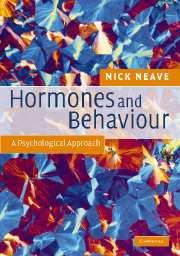Book contents
- Frontmatter
- Contents
- List of diagrams
- Preface
- Acknowledgements
- 1 Background to psychobiology
- 2 Hormones and the endocrine system
- 3 Behavioural endocrinology
- 4 Neurological effects of hormones
- 5 Typical sexual determination/differentiation
- 6 Atypical sexual differentiation
- 7 Neural differentiation
- 8 Reproductive/sexual behaviours
- 9 Attachment/parental behaviours
- 10 Aggressive/competitive behaviours
- 11 Sex steroids and cognition
- References
- Index
8 - Reproductive/sexual behaviours
Published online by Cambridge University Press: 05 June 2012
- Frontmatter
- Contents
- List of diagrams
- Preface
- Acknowledgements
- 1 Background to psychobiology
- 2 Hormones and the endocrine system
- 3 Behavioural endocrinology
- 4 Neurological effects of hormones
- 5 Typical sexual determination/differentiation
- 6 Atypical sexual differentiation
- 7 Neural differentiation
- 8 Reproductive/sexual behaviours
- 9 Attachment/parental behaviours
- 10 Aggressive/competitive behaviours
- 11 Sex steroids and cognition
- References
- Index
Summary
Previous chapters have adopted a unidirectional stance outlining the presumed causal relationship between hormone secretion and physiological/neurological differentiation. In chapter 3, however, remember that I raised issues of causality, and discussed the key difficulty facing behavioural endocrinologists in attempting to decide whether alterations in hormone levels influence a behaviour in question, or whether the onset or termination of a particular behaviour has a subsequent effect on hormone levels. Human behavioural endocrinological studies have tended to focus their attention on the former, and have thus mainly considered the effects of hormones on behaviour (van Anders and Watson, 2006a). With regard to reproductive behaviours (and the kinds of behaviours we will consider in subsequent chapters) it becomes increasingly obvious that we must also consider the reverse relationship – how behaviour may affect hormone levels.
One problem relates to defining what we mean by sexual behaviours; a further issue concerns how we may compare such behaviours between the sexes, and indeed between species. As regards the former, sexual behaviours are simply a set of actions with the primary aim of ensuring that the male sperm is delivered successfully to the female ova. The motivational force that drives individuals to seek out members of the opposite sex and copulate with them has been called ‘sex drive’ or ‘libido’. It is typically noted that in most species sex drive is stronger in males than in females, arguably because the two sexes have different pathways to reproductive success.
- Type
- Chapter
- Information
- Hormones and BehaviourA Psychological Approach, pp. 154 - 190Publisher: Cambridge University PressPrint publication year: 2007



